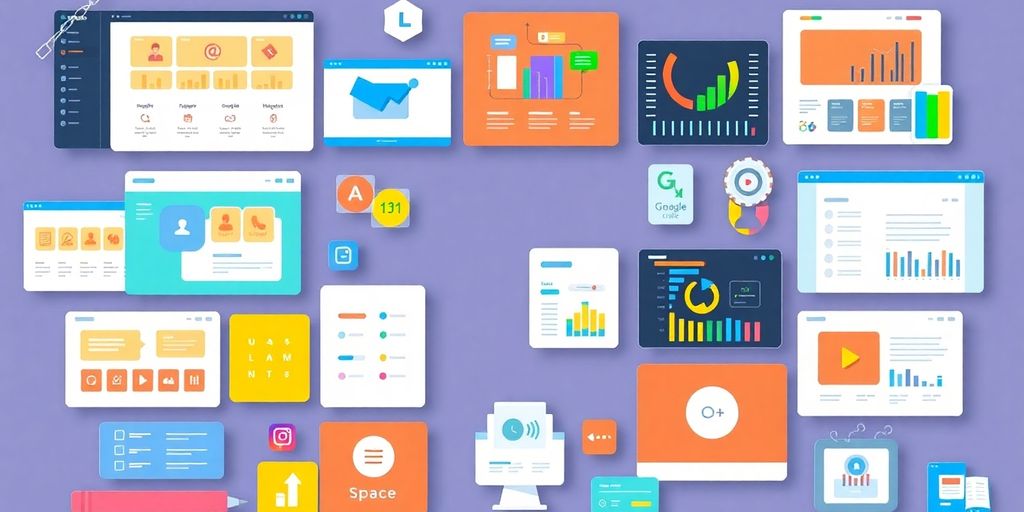Trello Alternatives: Project Management Beyond Boards

If you’ve been using Trello for your project management needs, you might have noticed some limitations. While it’s a popular choice, it’s not always the best fit for every team or project. Luckily, there are plenty of alternatives out there that might suit your needs better. In this article, we’ll explore some Trello alternatives: project management beyond boards, helping you find the right tool for your workflow.
Key Takeaways
- Trello can struggle with large projects, leading to performance issues.
- For teams needing advanced features, Trello might fall short.
- There are several free tools like Plaky and Nuclino that offer solid project management capabilities.
- Paid options like Asana and ClickUp provide customizable features that can enhance productivity.
- When choosing a tool, consider your team’s specific needs, collaboration features, and integration capabilities.
Understanding Trello Limitations

Trello is great for simple project management, but it’s not perfect. As projects grow or teams get more complex, some limitations become pretty obvious. It’s like using a basic toolbox when you really need a full workshop – you can make do for a while, but eventually, you’ll hit a wall.
Performance Issues with Large Boards
Ever notice Trello slowing down when you have tons of cards and lists? You’re not alone. One of the biggest complaints is performance degradation with large boards. It can get frustrating when you’re waiting for the board to load or for actions to register. It’s like trying to drive a car with a clogged engine – it sputters and stalls. This is especially true if you’re using lots of images or attachments. The more data, the slower it gets. It’s a common issue, and it can really impact productivity. It’s worth considering if you plan on having a lot of tasks.
Feature Limitations for Complex Projects
While Trello excels at basic Kanban-style task management, it can fall short for more complex projects. Advanced features like dependencies, resource management, and detailed reporting are often missing or require third-party integrations. It’s like having a simple calculator when you need to solve calculus problems – it just won’t cut it. For example, if you need to track how tasks relate to each other, or how much time each person is spending on a task, Trello might not be the best fit. It’s great for simple workflows, but not so much for intricate ones. Consider these points:
- Lack of built-in time tracking.
- Limited options for task dependencies.
- Basic reporting capabilities.
Pricing Concerns for Small Teams
For small teams, Trello’s pricing can be a bit of a hurdle. While it offers a free plan, it’s often too limited for serious project management. The paid plans can add up quickly, especially as your team grows. It’s like paying for a premium gym membership when you only use a few machines. You might find yourself paying for features you don’t really need. It’s worth comparing the pricing of Trello alternatives to see if there’s a more cost-effective option for your team. It’s all about finding the right balance between features and price.
Trello’s pricing structure can be a barrier for smaller teams or individual users who need more than the basic features but can’t justify the cost of a full-fledged subscription. This can lead to a search for more affordable alternatives that offer a better value proposition.
Exploring Free Alternatives

Trello’s simplicity is great, but sometimes you need more without spending money. Luckily, there are some solid free project management tools out there. These options often provide a good balance of features and usability, making them ideal for individuals, small teams, or anyone just wanting to test the waters before committing to a paid plan. Let’s check out a few.
Plaky: A Comprehensive Free Tool
Plaky is a project management software that offers a generous free plan. It includes Kanban boards, list views, and Gantt charts, giving you multiple ways to visualize your projects. You also get task dependencies, custom fields, and basic automation features, all without paying a dime. It’s a pretty fast tool, which is a nice bonus. If you’re looking for something that gives you a lot of features without costing anything, Plaky is worth checking out.
Nuclino: Minimalist Project Management
Nuclino takes a different approach. Instead of trying to be everything to everyone, it focuses on simplicity and ease of use. It’s great for teams that need a central place to organize knowledge and collaborate on projects without a lot of bells and whistles. Think of it as a lightweight workspace where you can create documents, organize them visually, and manage tasks in a straightforward way. It might not have all the advanced features of some other tools, but its minimalist design can be a real advantage if you want to avoid feeling overwhelmed.
Taiga: Visual Project Management
Taiga is an open-source project management platform that’s particularly well-suited for agile teams. It offers a range of visual tools, including Kanban boards, sprint planning features, and burndown charts. What sets Taiga apart is its focus on flexibility and customization. You can tailor it to fit your specific workflow and project needs. Plus, because it’s open-source, you have a lot of control over your data and how the platform is used. If you’re comfortable with a bit of a learning curve and want a powerful, customizable free option, Taiga is a good choice.
Choosing a free project management tool really comes down to what you need. Consider the size of your team, the complexity of your projects, and the features that are most important to you. Don’t be afraid to try out a few different options before settling on one.
Paid Alternatives Worth Considering
While free project management tools can be a great starting point, sometimes you need more power and features. That’s where paid alternatives come in. They often provide advanced functionalities, better support, and greater customization options. Let’s explore some paid options that might be a good fit for your team.
Asana: Advanced Task Management
Asana is a popular choice for teams that need robust task management capabilities. It excels at organizing projects, assigning tasks, setting deadlines, and tracking progress. It’s more than just a basic to-do list; it offers features like dependencies, custom fields, and reporting to help you manage complex projects effectively. Asana’s strength lies in its ability to handle intricate workflows and provide a clear overview of project status. It’s a solid pick if you need to keep a close eye on every detail.
Wrike: Robust Collaboration Features
Wrike is designed for teams that need strong collaboration tools. It offers features like real-time editing, shared workspaces, and communication tools to keep everyone on the same page. Wrike is particularly useful for teams that work on projects with many moving parts and require seamless communication. It’s a bit more complex than some other options, but the robust features make it worth considering if collaboration is a top priority.
ClickUp: Customizable Project Views
ClickUp is known for its extreme customization. You can tailor the platform to fit your specific needs, choosing from a variety of views, including Kanban boards, lists, calendars, and Gantt charts. This flexibility makes it a good choice for teams that want to work in a way that suits them best. ClickUp can be a bit overwhelming at first due to the sheer number of options, but once you get the hang of it, it can be a powerful tool. It’s a good option if you want a project management platform that can adapt to your unique workflow.
Choosing a paid project management tool is an investment, so it’s important to carefully consider your needs and budget. Many platforms offer free trials, so take advantage of those to see if a particular tool is a good fit for your team. Don’t be afraid to experiment and find the solution that works best for you.
Choosing the Right Alternative
It’s easy to get lost in the features and promises of different project management tools. The key is to take a step back and really think about what your team needs. Don’t just jump on the bandwagon of the latest shiny tool. A bit of planning can save you a lot of headaches down the road.
Assessing Your Project Management Needs
First, figure out what’s not working with your current system. Are you struggling with task assignment? Is communication a mess? Are deadlines constantly being missed? Identifying your pain points is the first step. Think about the types of projects you typically handle. Are they simple and straightforward, or complex with lots of dependencies? Do you need advanced features like time tracking or resource management? Understanding your project complexity will help you narrow down your options. For example, if you need a tool that can handle complex projects, then you should consider advanced task management.
Evaluating Collaboration Features
Collaboration is key for most teams. Look for features that make it easy for team members to communicate, share files, and provide feedback. Does the tool offer real-time updates? Can you easily assign tasks and track progress? Are there built-in communication tools, or does it integrate with your existing communication platforms like Slack or Microsoft Teams? Consider these points:
- Real-time collaboration features
- Easy file sharing and feedback mechanisms
- Integration with existing communication tools
Considering Integration Capabilities
No project management tool exists in a vacuum. It needs to play well with the other tools you’re already using. Think about the integrations that are essential for your workflow. Does it need to connect with your CRM, your accounting software, or your code repository? Check if the tool offers native integrations with these platforms. If not, does it support integrations through services like Zapier? Also, consider whether you need Kanban tools to visualize your workflow.
Choosing the right project management tool is a big decision. Don’t rush into it. Take the time to assess your needs, evaluate your options, and involve your team in the process. The goal is to find a tool that makes your work easier, not harder.
User Experience and Interface
When choosing a project management tool, it’s easy to get caught up in features and pricing. But let’s be real, if the thing is a pain to use, nobody’s gonna use it. That’s why user experience (UX) and interface (UI) are super important. A good UX/UI can make or break a team’s adoption of a new tool. It’s not just about looks; it’s about how intuitive and efficient the tool is.
Intuitive Design for New Users
The easier a tool is to pick up, the faster your team can start being productive. Nobody wants to spend weeks learning a new system. Look for tools with clear navigation, simple workflows, and helpful onboarding resources. A clean, uncluttered interface is a huge plus. Think about it: are the key features easy to find? Can you quickly create a task or project without digging through menus? If the answer is yes, you’re on the right track. If you’re evaluating outdoor apps, consider the GPS capabilities of each.
Customization Options for Teams
Every team works differently, so a one-size-fits-all approach rarely works. The best project management tools offer customization options to tailor the interface to your team’s specific needs. This could include:
- Customizable dashboards: Display the information that’s most relevant to each team member.
- Personalized views: Allow users to view tasks and projects in different formats (e.g., list, Kanban board, calendar).
- Custom fields: Add extra information to tasks and projects to track specific data points.
Customization isn’t just about aesthetics; it’s about creating a workspace that supports your team’s unique workflow and helps them stay organized.
Mobile Accessibility and Usability
In today’s world, people need to be able to access their project management tools from anywhere. A well-designed mobile app is no longer a luxury; it’s a necessity. The mobile app should offer the same core functionality as the desktop version, with an interface that’s optimized for smaller screens. Things to look for include:
- Responsive design: The app should adapt to different screen sizes and orientations.
- Offline access: The ability to view and update tasks even without an internet connection.
- Push notifications: Real-time alerts for new tasks, comments, and deadlines.
Integrations and Compatibility
Project management tools don’t exist in a vacuum. They need to play nice with the other software you’re already using. Let’s talk about how these Trello alternatives stack up when it comes to integrations and compatibility.
Connecting with Other Tools
This is where things can get interesting. A project management tool that can’t connect to your existing workflow is like a car with square wheels – technically functional, but deeply unpleasant. Most platforms offer integrations with popular services like Google Workspace, Microsoft Office, Slack, and various CRM and accounting software. The depth of these integrations, however, can vary wildly. Some might just offer basic file sharing, while others allow for automated task creation and real-time data syncing. It’s worth checking if your mission-critical tools are supported, and to what extent.
- Email marketing platforms
- Customer support software
- Code repositories
API Access for Custom Solutions
For teams with specific needs, API access is a game-changer. An API (Application Programming Interface) allows you to build custom integrations that aren’t available out-of-the-box. This is especially useful if you have internal tools or workflows that need to be connected to your project management system. The quality of the API documentation and the ease of use are important factors to consider. A well-documented API can save developers a lot of time and frustration.
Cross-Platform Functionality
In today’s world, people work on all sorts of devices. A project management tool that’s only accessible on a desktop is a major limitation. Cross-platform functionality means that the tool is available on web browsers, desktop apps (Windows, macOS, Linux), and mobile apps (iOS, Android). The experience should be consistent across all platforms, with all features available regardless of the device you’re using. This ensures that team members can stay connected and productive, no matter where they are. In 2024, the need for global cooperation is more important than ever.
A good project management tool should fit into your existing ecosystem, not the other way around. Think about the tools you use daily and make sure your chosen alternative can integrate with them seamlessly. Otherwise, you’re just creating more work for yourself.
Future Trends in Project Management Tools
Emerging Technologies in Project Management
Project management is on the cusp of some pretty big changes, thanks to new tech. We’re not just talking about slightly better software; it’s more like a shift in how we even think about managing projects. Things like machine learning and the Internet of Things (IoT) are starting to play a role. Imagine sensors on construction sites feeding real-time data directly into your project plan, or AI predicting potential delays before they even happen. It’s a wild time to be in project management. For example, you can manage project timelines with the help of AI.
The Shift Towards Remote Collaboration
Remote work is here to stay, and project management tools are adapting fast. It’s not enough to just have a place to store files; teams need ways to really collaborate, even when they’re miles apart. Think interactive whiteboards built right into project software, better video conferencing integration, and tools that make asynchronous communication feel more natural. The focus is on making remote teams feel like they’re in the same room, even if they’re spread across the globe. It’s all about keeping everyone connected and on the same page, no matter where they are.
AI and Automation in Task Management
AI is making its way into task management, and it’s doing more than just suggesting due dates. We’re seeing AI take on repetitive tasks, automate workflows, and even help with decision-making. Imagine an AI that can automatically assign tasks based on team member skills and availability, or one that can identify potential bottlenecks in a project timeline. It’s not about replacing project managers, but about giving them superpowers. This means project managers can focus on the bigger picture, like strategy and team leadership, while AI handles the day-to-day grind.
The rise of AI and automation in project management isn’t just about efficiency; it’s about freeing up human project managers to focus on the more creative and strategic aspects of their roles. This shift allows for better problem-solving, improved team dynamics, and ultimately, more successful project outcomes.
Wrapping It Up
In the end, finding the right project management tool is all about what works best for you and your team. Trello has its perks, but it’s not the only game in town. If you’re feeling stuck or overwhelmed, it might be time to explore some alternatives. There are plenty of options out there, each with its own unique features and benefits. Whether you need something simple or a tool that can handle complex projects, there’s likely a better fit for your needs. So take a look at the alternatives we discussed, and don’t hesitate to try a few out. You might just find the perfect tool to help you manage your projects more effectively.
Frequently Asked Questions
What are some common problems with Trello?
Trello can slow down when you have a lot of tasks on your boards. Some users also feel it lacks features for more complicated projects.
Are there free tools that work like Trello?
Yes! Tools like Plaky, Nuclino, and Taiga offer great project management features for free.
What paid options can I consider instead of Trello?
Asana, Wrike, and ClickUp are popular paid alternatives that provide more advanced features.
How do I pick the best tool for my team?
Think about what features you need, how your team collaborates, and whether the tool works well with other software you use.
Is it easy to use alternatives to Trello?
Most alternatives aim to be user-friendly, but it’s a good idea to try a few to see which one feels best for you and your team.
What future trends should I know about in project management tools?
Look out for new tech like AI and automation that can help make managing tasks easier, especially for remote teams.








Responses